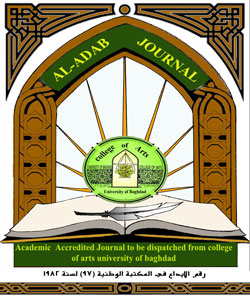Cartographic representation of urban expansion on the vegetation cover and the basic design of Al-Nasiriyah city using GIS techniques
DOI:
https://doi.org/10.31973/aj.v0i129.574Keywords:
Cartography, UrbanismAbstract
The aim of this study is to use remote sensing techniques and geographic information systems to study and detect changes in the uses of urban land and green areas within the boundaries of the basic design and beyond the Nasiriyah civilization, based on the field study and basic designs prepared for the study area, as well as analysis and classification of satellite images taken by the moon Industrial Landsat (MSS) for the year 1970 and with (OLI) for the year 2016 for the purpose of monitoring changes in vegetation cover for the period 1970 to 2016. The production of digital maps to overcome urban land use on the common ground cover The classification of the city includes the category of barren land, agricultural land, urban land and marshes. The study showed that there were clear changes in the vegetation cover during the period from 1970 to 2016, which was the expansion of the type of urban land and the extension of its residential units at the expense of the agricultural land represented in the palm groves, which led to a decrease in area and especially after the events of 2003 It has resulted in a huge urban expansion at the expense of green areas. The total area of residential land during the year 2016 was (5631.2) hectares. Compared with (691.5)hectares in 1970 while the area of agricultural land decreased to (4866.9) hectares before it reached (6988.7) hectares in the area of (1511.9) hectares in 2016 of the total area of the city of Nasiriyah .
Downloads
References
Abbas Abdul-Hasan Kazem and Muhammad Samir, the housing movement and its social variables in the city of Basra, Journal of the College of Arts, Volume 2, No. 54, the issue of the Second Scientific Conference of the College of Arts, 2010, p. 209.
Alaa Nabil Hamdoun Mahmoud Al-Abadi, Applications of Remote Sensing in the Study of Geomorphological Features and Changes in Land Use in and around Dohuk City and its Future Expansion, Master Thesis, Unpublished, College of Science, University of Mosul, 2002.
Buring soil and soil conditions in Iraq ministry of agricutre Baghdad 1960 pp25.
Fahd Ahmad Farhan Al-Amoud, Spatial Analysis of Factors Affecting Irrigation Water and Soil Pollution in Souk Al-Shuyoukh District, Master Thesis, unpublished, College of Education, Basra University, 2010, p. 29.
Hassan Sawadi Najeeban Al-Ghazi, Land Cover Changes in Hor Al-Hammar for the Period 1973 - 2008 Using Remote Sensing Techniques, PhD Thesis, Unpublished, College of Education, Basra University, 2010.
LU, Mausel. P, Brondizio and Moran,E ,Change detection techniques ,International journal of remote sensing ,VOL.25,NO.12 ,2003, p.236
Ministry of Transport and Communications, General Authority of Meteorology, Nasiriyah Monitoring Station - Climate Section, unpublished data for the period 1980-2016 AD.
Murtaza Muzaffar Sahar Al-Kaabi, Spatial Analysis of Changing Residential Land Use in Basra City Using Remote Sensing and Geographic Information Systems (GIS), Part One, PhD thesis, College of Education for Human Sciences, Basra University, 2017, p. 139.
Najm Abdullah Rahim Al-Abdullah, Physical and chemical properties of the soil of Dhi Qar Governorate and their effects on agricultural production (a study in soil geography), unpublished doctoral thesis, College of Arts, Basra University, 2006, p.16.
Ruqayya Ahmad Muhammad Amin Al-Ani, Study of Land Cover Changes in Balad Region Using Digital Processing Methods and Automatic Classification of Remote Sensitivity Data, Master Thesis, unpublished, College of Education, University of Tikrit, 2004.
Sahar Tariq Abdul-Karim Al-Mulla, Geomorphology of the Shatt Al-Arab Valley with the Help of Remote Sensing Techniques, Unpublished PhD thesis, Faculty of Arts, University of Basra, 2005.
Tariq Jumaa Ali Al-Mawla, Mapping Representation of Land Cover Changes in Basra Governorate Using Remote Sensing and Geographic Information Systems for the Period 1973-2013, Part One, Unpublished PhD thesis, College of Education for Human Sciences, Basra University, 2014, p. 124.
Downloads
Published
Issue
Section
License
Copyright and Licensing:
For all articles published in Al-Adab journal, copyright is retained by the authors. Articles are licensed under an open access Creative Commons CC BY 4.0 license, meaning that anyone may download and read the paper for free. In addition, the article may be reused and quoted provided that the original published version is cited. These conditions allow for maximum use and exposure of the work.
Reproducing Published Material from other Publishers: It is absolutely essential that authors obtain permission to reproduce any published material (figures, schemes, tables or any extract of a text) which does not fall into the public domain, or for which they do not hold the copyright. Permission should be requested by the authors from the copyrightholder (usually the Publisher, please refer to the imprint of the individual publications to identify the copyrightholder).
Permission is required for: Your own works published by other Publishers and for which you did not retain copyright.
Substantial extracts from anyones' works or a series of works.
Use of Tables, Graphs, Charts, Schemes and Artworks if they are unaltered or slightly modified.
Photographs for which you do not hold copyright.
Permission is not required for: Reconstruction of your own table with data already published elsewhere. Please notice that in this case you must cite the source of the data in the form of either "Data from..." or "Adapted from...".
Reasonably short quotes are considered fair use and therefore do not require permission.
Graphs, Charts, Schemes and Artworks that are completely redrawn by the authors and significantly changed beyond recognition do not require permission.
Obtaining Permission
In order to avoid unnecessary delays in the publication process, you should start obtaining permissions as early as possible. If in any doubt about the copyright, apply for permission. Al-Adab Journal cannot publish material from other publications without permission.
The copyright holder may give you instructions on the form of acknowledgement to be followed; otherwise follow the style: "Reproduced with permission from [author], [book/journal title]; published by [publisher], [year].' at the end of the caption of the Table, Figure or Scheme.












